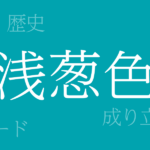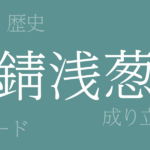Japan’s four seasons are renowned for their diverse colors, deeply ingrained in people’s lives since ancient times. Among them, traditional Japanese colors possess a unique beauty and significance, captivating designers and artists worldwide. Among these, “水浅葱” (みずあさぎ, Mizu-asagi) stands as a symbol of Japan’s nature and culture. This article delves into the allure of 水浅葱, exploring its history, color codes, and Western name.
About 水浅葱 (みずあさぎ, Mizu-asagi)
水浅葱 (みずあさぎ, Mizu-asagi) boasts a refreshing blue-green hue, particularly renowned for its cool impression among traditional Japanese colors. Its name originates from the asagi plant that grows by water, reflecting the color of its leaves. This serene yet profound color finds application in various contexts, from traditional kimono and Japanese paintings to contemporary designs.
History of 水浅葱 (みずあさぎ, Mizu-asagi)
The history of 水浅葱 (みずあさぎ, Mizu-asagi) dates back to the Heian period when aristocrats adorned their attire with natural colors, depicting the changing seasons. 水浅葱 became one such favored color. During the Edo period, its popularity surged, beloved by samurai and townspeople alike. Today, 水浅葱 continues to symbolize Japanese culture, utilized in traditional ceremonies and fashion.
Color Codes for 水浅葱 (みずあさぎ, Mizu-asagi)
For accurate reproduction of 水浅葱 (みずあさぎ, Mizu-asagi) in digital designs or prints, knowing its color codes is essential. Below are the color codes for 水浅葱:
- HEX: #80ABA9
- RGB: R:128 G:171 B:169
- CMYK: C:55 M:24 Y:35 K:0
Western Name for 水浅葱 (みずあさぎ, Mizu-asagi)
The Western name for 水浅葱 (みずあさぎ, Mizu-asagi) is “Asagi Blue.” While this translates to “light blue,” it’s a commonly used term in Western contexts to describe this unique shade. In fields like interior design and fashion, 水浅葱 is highly regarded for its exotic appeal.
Summary of 水浅葱 (みずあさぎ, Mizu-asagi)
水浅葱 (みずあさぎ, Mizu-asagi) continues to be cherished for its history, beauty, and cultural significance, inspiring many. In the digital era, understanding its color codes allows people worldwide to incorporate this traditional color into their creations. Additionally, the Western name “Asagi Blue” serves as a bridge for conveying the charm of this color in international communication. 水浅葱, blending tradition and innovation, will undoubtedly continue to inspire people for generations to come.

























